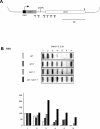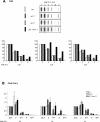Budding yeast RNA polymerases I and II employ parallel mechanisms of transcriptional termination
- PMID: 18413718
- PMCID: PMC2335328
- DOI: 10.1101/gad.463408
Budding yeast RNA polymerases I and II employ parallel mechanisms of transcriptional termination
Abstract
Both RNA polymerase I and II (Pol I and Pol II) in budding yeast employ a functionally homologous "torpedo-like" mechanism to promote transcriptional termination. For two well-defined Pol II-transcribed genes, CYC1 and PMA1, we demonstrate that both Rat1p exonuclease and Sen1p helicase are required for efficient termination by promoting degradation of the nascent transcript associated with Pol II, following mRNA 3' end processing. Similarly, Pol I termination relies on prior Rnt1p cleavage at the 3' end of the pre-rRNA 35S transcript. This is followed by the combined actions of Rat1p and Sen1p to degrade the Pol I-associated nascent transcript that consequently promote termination in the downstream rDNA spacer sequence. Our data suggest that the previously defined in vitro Pol I termination mechanism involving the action of the Reb1p DNA-binding factor to "road-block" Pol I transcription close to the termination region may have overlooked more complex in vivo molecular processes.
Figures







Similar articles
-
Efficient termination of transcription by RNA polymerase I requires the 5' exonuclease Rat1 in yeast.Genes Dev. 2008 Apr 15;22(8):1069-81. doi: 10.1101/gad.463708. Genes Dev. 2008. PMID: 18413717 Free PMC article.
-
Co-transcriptional RNA cleavage provides a failsafe termination mechanism for yeast RNA polymerase I.Nucleic Acids Res. 2011 Mar;39(4):1439-48. doi: 10.1093/nar/gkq894. Epub 2010 Oct 23. Nucleic Acids Res. 2011. PMID: 20972219 Free PMC article.
-
Transcription termination of RNA polymerase I due to a T-rich element interacting with Reb1p.Proc Natl Acad Sci U S A. 1995 Oct 10;92(21):9781-5. doi: 10.1073/pnas.92.21.9781. Proc Natl Acad Sci U S A. 1995. PMID: 7568217 Free PMC article.
-
The mechanism of transcription termination by RNA polymerase I.Mol Microbiol. 1994 Apr;12(1):11-5. doi: 10.1111/j.1365-2958.1994.tb00989.x. Mol Microbiol. 1994. PMID: 8057832 Review.
-
RNA-polymerase-I-directed rDNA transcription, life and works.Trends Biochem Sci. 2005 Feb;30(2):87-96. doi: 10.1016/j.tibs.2004.12.008. Trends Biochem Sci. 2005. PMID: 15691654 Free PMC article. Review.
Cited by
-
Alternative chromatin structures of the 35S rRNA genes in Saccharomyces cerevisiae provide a molecular basis for the selective recruitment of RNA polymerases I and II.Mol Cell Biol. 2010 Apr;30(8):2028-45. doi: 10.1128/MCB.01512-09. Epub 2010 Feb 12. Mol Cell Biol. 2010. PMID: 20154141 Free PMC article.
-
Mechanism of start site selection by RNA polymerase II: interplay between TFIIB and Ssl2/XPB helicase subunit of TFIIH.J Biol Chem. 2012 Jan 2;287(1):557-567. doi: 10.1074/jbc.M111.281576. Epub 2011 Nov 11. J Biol Chem. 2012. PMID: 22081613 Free PMC article.
-
Control of mammalian retrotransposons by cellular RNA processing activities.Mob Genet Elements. 2014 Mar 6;4:e28439. doi: 10.4161/mge.28439. eCollection 2014. Mob Genet Elements. 2014. PMID: 25346866 Free PMC article.
-
Co-transcriptional degradation of aberrant pre-mRNA by Xrn2.EMBO J. 2012 May 30;31(11):2566-78. doi: 10.1038/emboj.2012.101. Epub 2012 Apr 20. EMBO J. 2012. PMID: 22522706 Free PMC article.
-
Disengaging polymerase: terminating RNA polymerase II transcription in budding yeast.Biochim Biophys Acta. 2013 Jan;1829(1):174-85. doi: 10.1016/j.bbagrm.2012.10.003. Epub 2012 Oct 17. Biochim Biophys Acta. 2013. PMID: 23085255 Free PMC article. Review.
References
-
- Alen C., Kent N.A., Jones H.S., O’Sullivan J., Aranda A., Proudfoot N.J. A role for chromatin remodeling in transcriptional termination by RNA polymerase II. Mol. Cell. 2002;10:1441–1452. - PubMed
-
- Arigo J.T., Eyler D.E., Carroll K.L., Corden J.L. Termination of cryptic unstable transcripts is directed by yeast RNA-binding proteins Nrd1 and Nab3. Mol. Cell. 2006;23:841–851. - PubMed
-
- Birse C.E., Minvielle-Sebastia L., Lee B.A., Keller W., Proudfoot N.J. Coupling termination of transcription to messenger RNA maturation in yeast. Science. 1998;280:298–301. - PubMed
-
- Braglia P., Percudani R., Dieci G. Sequence context effects on oligo(dT) termination signal recognition by Saccharomyces cerevisiae RNA polymerase III. J. Biol. Chem. 2005;280:19551–19562. - PubMed
Publication types
MeSH terms
Substances
Grants and funding
LinkOut - more resources
Full Text Sources
Other Literature Sources
Molecular Biology Databases
Miscellaneous
